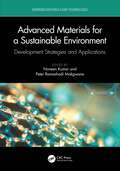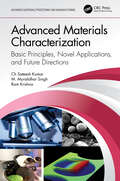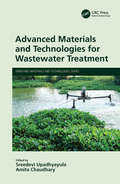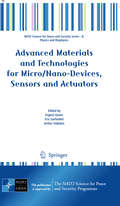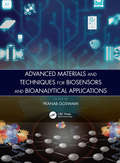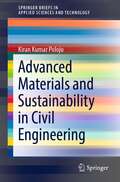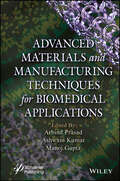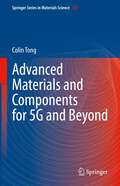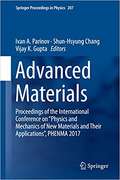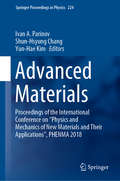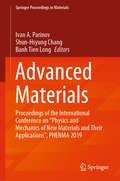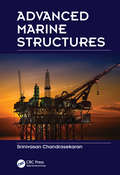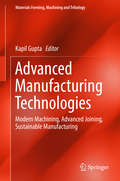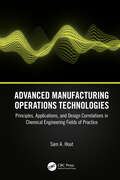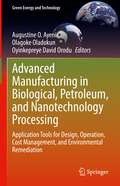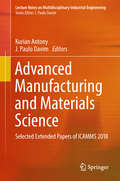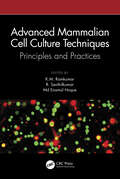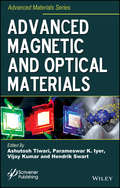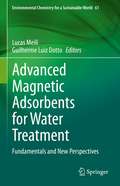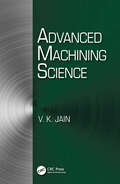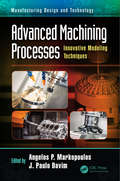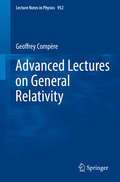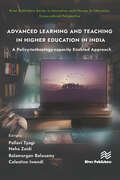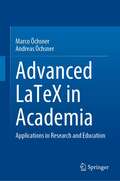- Table View
- List View
Advanced Materials for a Sustainable Environment: Development Strategies and Applications (Emerging Materials and Technologies)
by Peter Ramashadi Makgwane Naveen KumarThis book summarizes recent and critical aspects of advanced materials for environmental protection and remediation. It explores the various development aspects related to environmental remediation, including design and development of novel and highly efficient materials, aimed at environmental sustainability. Synthesis of advanced materials with desirable physicochemical properties and applications is covered as well. Distributed across 13 chapters, the major topics covered include sensing and elimination of contaminants and hazardous materials via advanced materials along with hydrogen energy, biofuels, and CO2 capture technology. Discusses the development in design of synthesis process and materials with sustainable approach. Covers removal of biotic and abiotic wastes from the aqueous systems. Includes hydrogen energy and biofuels under green energy production. Explores removal of environmental (soil and air) contaminants with nanomaterials. Reviews advanced materials for environmental remediation in both liquid and gas phases.
Advanced Materials Characterization: Basic Principles, Novel Applications, and Future Directions (Advanced Materials Processing and Manufacturing)
by Ch Sateesh Kumar M. Muralidhar Singh Ram KrishnaThe book covers various methods of characterization of advanced materials commonly used in engineering including understanding of the working principle and applicability of devices. It explores the techniques implemented for advanced materials like superalloys, thin films, powders, nanocomposites, polymers, shape memory alloys, high entropy alloys, and so on. Major instruments covered include X-ray diffraction, near-field scanning optical microscopy Raman, X-ray photospectroscopy, ultraviolet-visible-near-infrared spectrosphotometer, Fourier-transform infrared spectroscopy, differential scanning calorimeter, profilometer, and thermogravimetric analysis. Features: Covers material characterization techniques and the development of advanced characterization technology Includes multiple length scale characterization approaches for a large variety of materials, from nano- to micron-scale, as well as their constraints Discusses advanced material characterization technology in the microstructural and property characterization fields Reviews both practical and theoretical explanations of approaches for characterizing microstructure and properties Offers fundamentals, basic instrumentation details, experimental approaches, analyses, and applications with case studies This book is aimed at graduate students and researchers in materials science and engineering.
Advanced Materials and Technologies for Wastewater Treatment (Emerging Materials and Technologies)
by Sreedevi Upadhyayula Amita ChaudharyAdvanced Materials and Technologies for Wastewater Treatment discusses the methods and technologies of physical, chemical, biological, and thermo-catalytic treatment techniques. It includes the treatment of waste generated by municipal, agro-industry, and other industries including chemical, biomedical, pharmaceutical, textile, and other sectors. FEATURES Covers implementation of advanced water and wastewater treatment techniques, with a focus on pollutant or pathogen removal Includes qualitative and quantitative analyses Focuses on physical, chemical, and biological treatment technologies Discusses the advancements of materials and technologies applicable to both potable water and wastewater from industrial and municipal sources Explores future challenges and viable solutions This book is aimed at chemical and environmental engineers and researchers seeking a thorough treatment of innovative water treatment materials and techniques for practical applications.
Advanced Materials and Technologies for Micro/Nano-Devices, Sensors and Actuators (NATO Science for Peace and Security Series B: Physics and Biophysics)
by Arthur Dideikin Eric Garfunkel Evgeni GusevThe main goal of this book is to review recent progress and current status of MEMS/NEMS technologies and devices. Several important areas are discussed: history of research in the field, device physics, examples of sucessful applications, sensors, materials and processing aspects. The authors who have contributed to the book represent a diverse group of leading scientists from academic, industrial and governmental labs worldwide who bring a broad array of backgrounds such as device physics, technologists, electrical and mechanical engineering, surface chemistry and materials science). The contributions to this book are accessible to both expert scientists and engineers who need to keep up with leading edge research, and newcomers to the field who wish to learn more about the exciting basic and applied research issues relevant to micromechanical devices and technologies.
Advanced Materials and Techniques for Biosensors and Bioanalytical Applications
by Pranab GoswamiBioanalytical science and its technological subdomain, biosensors, are ever-evolving subjects, striving for rapid improvement in terms of performance and expanding the target range to meet the vast societal and market demands. The key performance factors for a biosensor that drive the research are selectivity, sensitivity, response time, accuracy, and reproducibility, with additional requirements of its portability and inexpensive nature. These performance factors are largely governed by the materials and techniques being used in these bioanalytical platforms. The selection of materials to meet these requirements is critical, as their interaction or involvement with the biological recognition elements should initiate or improve these performance factors. The technique discussed primarily applies to transducers involved in converting a biochemical signal to optical or electrical signals. Over the years, the emergence of novel materials and techniques has drastically improved the performance of these bioanalytical systems, enabling them to expand their analytical horizon. These advanced materials and techniques are central to modern bioanalytical and biosensor research. Advanced Materials and Techniques for Biosensors and Bioanalytical Applications provides a comprehensive review of the subject, including a knowledge platform for both academics and researchers. Considering biosensors as a central theme to this book, an outline on this subject with background principles has been included, with a scope of extending the utility of the book to coursework in graduate and postgraduate schools. Features: • Basic principles on different classes of biosensors, recent advances and applications • Smart materials for biosensors and other rapid, portable detection devices • Metal nanoparticles and nanocrystals for analytical applications • Carbon-based nanoparticles and quantum dots for sensing applications • Nanozymes as potential catalysts for sensing applications • Bioelectrochemiluminescence and photoelectrochemical-based biosensors • Paper electronics and paper-based biosensors • Microbial biosensors: artificial intelligence, genetic engineering, and synthetic biology • Biofuel cells as a signal transduction platform • FET-based biosensors, including ISFET and BioFET This book serves as a reference for scientific investigators and a textbook for a graduate-level course in biosensors and advanced bioanalytical techniques.
Advanced Materials and Sustainability in Civil Engineering (SpringerBriefs in Applied Sciences and Technology)
by Kiran Kumar PolojuThis book discusses the detailed concepts of concrete and its development with pros and cons. Besides, the significance of various industrial wastes as partial replacements with concrete ingredients such as cement and aggregates are discussed. The creation of cement contributes to around 7% of carbon emissions into the atmosphere leading to greenhouse effect and global warming. Similarly, the wastes generated from various industries such as thermal, steel, ceramic, marble, paper and etc. shows the impact on atmosphere and leads to air pollution and land pollution. Thus, it is essential to focus on these wastes to use them in a profitable manner without compromising the current needs. This book discusses a few examples on studies of using various industry wastes as partial replacement of cement in concrete
Advanced Materials and Manufacturing Techniques for Biomedical Applications (Advances In Manufacturing, Design And Computational Intelligence Techniques Ser.)
by Arbind Prasad Ashwani Kumar Manoj GuptaADVANCED MATERIALS and MANUFACTURING TECHNIQUES for BIOMEDICAL APPLICATIONS The book provides essential knowledge for the synthesis of biomedical products, development, nanomaterial properties, fabrication processes, and design techniques for different applications, as well as process design and optimization. In origin, biomaterials can come from nature or be synthesized in the laboratory with a variety of approaches that use metals, polymers, ceramic, or composite materials. They are often used or adapted for various biomedical applications. Biomaterials are commonly used in scaffolds, orthopedic, wound healing, fracture fixation, surgical sutures, artificial organ developments, pins and screws to stabilize fractures, surgical mesh, breast implants, artificial ligaments and tendons, and drug delivery systems. The sixteen chapters in Advanced Materials and Manufacturing Techniques in Biomedical Applications cover the synthesis, processing, design, manufacturing, and characterization of advanced materials; self-healing, bioinspired, nature-resourced, nanobiomaterials for biomedical applications; and manufacturing techniques such as rapid prototyping, additive manufacturing, etc. Audience The book is for engineers, technologists, and researchers working in the area of biomedical engineering and manufacturing techniques. It is also appropriate for upper-level undergraduate and graduate students.
Advanced Materials and Components for 5G and Beyond (Springer Series in Materials Science #327)
by Colin TongThis book provides a comprehensive introduction to the current status and future trends of materials and component design for fifth-generation (5G) wireless communications and beyond. Necessitated by rapidly increasing numbers of mobile devices and data volumes, and acting as a driving force for innovation in information technology, 5G networks are broadly characterized by ubiquitous connectivity, extremely low latency, and very high-speed data transfer. Such capabilities are facilitated by nanoscale and massive multi-input multi-output (MIMO) with extreme base station and device densities, as well as unprecedented numbers of antennas. This book covers semiconductor solutions for 5G electronics, design and performance enhancement for 5G antennas, high frequency PCB materials and design requirements, materials for high frequency filters, EMI shielding materials and absorbers for 5G systems, thermal management materials and components, and protective packaging and sealing materials for 5G devices. It explores fundamental physics, design, and engineering aspects, as well as the full array of state-of-the-art applications of 5G-and-beyond wireless communications. Future challenges and potential trends of 5G-and-beyond applications and related materials technologies are also addressed. Throughout this book, illustrations clarify core concepts, techniques, and processes. At the end of each chapter, references serve as a gateway to the primary literature in the field. This book is essential reading for today’s students, scientists, engineers and professionals who want to understand the current status and future trends in materials advancement and component design in 5G and beyond, and acquire skills for selecting and using materials and 5G component design that takes economic and regulatory aspects into account.
Advanced Materials: Proceedings Of The International Conference On Physics And Mechanics Of New Materials And Their Applications , PHENMA 2017 (Springer Proceedings In Physics #207)
by Shun-Hsyung Chang Ivan A. Parinov Vijay K. GuptaProvides a consistent and original presentation of fabrication techniques, physics, mechanics, and applications of advanced materials and composites.<p><p> Helps readers to better understand modern R&D requirements for prospective materials and composites.<p> Features original theoretical, experimental and modeling results on novel materials and devices.<p> This book presents selected peer-reviewed contributions from the 2017 International Conference on “Physics and Mechanics of New Materials and Their Applications”, PHENMA 2017 (Jabalpur, India, 14–16 October, 2017), which is devoted to processing techniques, physics, mechanics, and applications of advanced materials. The book focuses on a wide spectrum of nanostructures, ferroelectric crystals, materials and composites as well as promising materials with special properties. It presents nanotechnology approaches, modern environmentally friendly piezoelectric and ferromagnetic techniques and physical and mechanical studies of the structural and physical–mechanical properties of materials. Various original mathematical and numerical methods are applied to the solution of different technological, mechanical and physical problems that are interesting from theoretical, modeling and experimental points of view. Further, the book highlights novel devices with high accuracy, longevity and extended capabilities to operate under wide temperature and pressure ranges and aggressive media, which show improved characteristics, thanks to the developed materials and composites, opening new possibilities for different physico-mechanical processes and phenomena
Advanced Materials: Proceedings of the International Conference on “Physics and Mechanics of New Materials and Their Applications”, PHENMA 2018 (Springer Proceedings in Physics #224)
by Ivan A. Parinov Shun-Hsyung Chang Yun-Hae KimThis book includes selected, peer-reviewed contributions from the 2018 International Conference on “Physics and Mechanics of New Materials and Their Applications”, PHENMA 2018, held in Busan, South Korea, 9–11 August 2018. Focusing on manufacturing techniques, physics, mechanics, and applications of modern materials with special properties, it covers a broad spectrum of nanomaterials and structures, ferroelectrics and ferromagnetics, and other advanced materials and composites. The authors discuss approaches and methods in nanotechnology; newly developed, environmentally friendly piezoelectric techniques; and physical and mechanical studies of the microstructural and other properties of materials. Further, the book presents a range of original theoretical, experimental and computational methods and their application in the solution of various technological, mechanical and physical problems. Moreover, it highlights modern devices demonstrating high accuracy, longevity and the ability to operate over wide temperature and pressure ranges or in aggressive media. The developed devices show improved characteristics due to the use of advanced materials and composites, opening new horizons in the investigation of a variety of physical and mechanical processes and phenomena.
Advanced Materials: Proceedings of the International Conference on “Physics and Mechanics of New Materials and Their Applications”, PHENMA 2019 (Springer Proceedings in Materials #6)
by Ivan A. Parinov Shun-Hsyung Chang Banh Tien LongThis book presents selected peer-reviewed contributions from the 2019 International Conference on “Physics and Mechanics of New Materials and Their Applications”, PHENMA 2019 (Hanoi, Vietnam, 7–10 November, 2019), divided into four scientific themes: processing techniques, physics, mechanics, and applications of advanced materials. The book describes a broad spectrum of promising nanostructures, crystals, materials and composites with special properties. It presents nanotechnology approaches, modern environmentally friendly techniques and physical-chemical and mechanical studies of the structural-sensitive and physical–mechanical properties of materials. The obtained results are based on new achievements in material sciences and computational approaches, methods and algorithms (in particular, finite-element and finite-difference modeling) applied to the solution of different technological, mechanical and physical problems. The obtained results have a significant interest for theory, modeling and test of advanced materials. Other results are devoted to promising devices demonstrating high accuracy, longevity and new opportunities to work effectively under critical temperatures and high pressures, in aggressive media, etc. These devices demonstrate improved comparative characteristics, caused by developed materials and composites, allowing investigation of physio-mechanical processes and phenomena based on scientific and technological progress.
Advanced Marine Structures
by Srinivasan ChandrasekaranDue in part to a growing demand for offshore oil and gas exploration, the development of marine structures that initially started onshore is now moving into deeper offshore areas. Designers are discovering a need to revisit basic concepts as they anticipate the response behavior of marine structures to increased water depths. Providing a sim
Advanced Manufacturing Technologies: Modern Machining, Advanced Joining, Sustainable Manufacturing (Materials Forming, Machining and Tribology)
by Kapil GuptaThis book provides details and collective information on working principle, process mechanism, salient features, and unique applications of various advanced manufacturing techniques and processes belong. The book is divided in three sessions covering modern machining methods, advanced repair and joining techniques and, finally, sustainable manufacturing. The latest trends and research aspects of those fields are highlighted.
Advanced Manufacturing Operations Technologies: Principles, Applications, and Design Correlations in Chemical Engineering Fields of Practice
by Sam A. HoutThis book discusses and chronicles various types of manufacturing processes, including casting and molding, machining, joining, shearing, and forming. It refers to repetitive, discrete job shop process manufacturing (continuous) and process manufacturing (batch). It also offers detailed examples from the nuclear, electronic, plastics, adhesives, inks, packaging, chemical, and pharmaceutical industries. Advanced Manufacturing Operations Technologies: Principles, Applications, and Design Correlations in Chemical Engineering Fields of Practice fills the gap in the connection between production and regulated applications in several industries. It highlights established concepts and provides a new, fresh outlook by concentrating on and creating linkages in the implementation of practices in manufacturing and safe, clean energy systems. Case studies for the overall design, installations, and construction of manufacturing operations in various industries as well as the standard operating procedures are offered. The book also discusses the correlation between design strategies including step-by-step processes to ensure the reliability, safety, and efficacy of products. The fundamentals of controlled techniques, quality by design, risk assessment, and management are covered in support of operations applications and continuous improvement. This comprehensive book is helpful to all professionals, students, and academicians in many scientific disciplines that utilize fundamental principles of chemical engineering. It is engineering-driven and will be of use to those in industrial and manufacturing, chemical, biochemical, mechanical engineering, and automated control systems fields.
Advanced Manufacturing in Biological, Petroleum, and Nanotechnology Processing: Application Tools for Design, Operation, Cost Management, and Environmental Remediation (Green Energy and Technology)
by Augustine O. Ayeni Olagoke Oladokun Oyinkepreye David OroduThis book covers advanced manufacturing in biological, petroleum, and nanotechnology processing for the development of novel products and systems that incorporate enhanced pollution control and waste management for environmental remediation. The book is divided into three parts. The first section looks at the design and application of process systems, the second section focuses largely on pollution control and management, and the final section discusses areas related to process modeling and simulation. Coverage highlights the integration of smart tools and solutions and looks at current advances in monitoring industrial and environmental processes that can assist in making significant progress in process design for the effective control of pollution and waste management.
Advanced Manufacturing and Materials Science: Selected Extended Papers Of ICAMMS 2018 (Lecture Notes On Multidisciplinary Industrial Engineering)
by Kurian Antony J. Paulo DavimPresents papers on additive manufacturing.<P><P> Peer reviewed chapters on recent advances in the manufacturing sector.<P> Discusses optimization processes in manufacturing.<P>This book presents selected papers from the international conference on advanced manufacturing and materials sciences (ICAMMS 2018). The papers reflet recent advances in manufacturing sector focusing on process optimization and give emphasis to testing and evaluation of new materials with potential use in industrial applications.
Advanced Mammalian Cell Culture Techniques: Principles and Practices
by K. M. Ramkumar R. Senthilkumar Md Enamul HoqueThis up-to-date book compiles both basic and advanced laboratory techniques of mammalian cell culture. It is divided into four major sections encompassing the basics of cell culture, nucleic acid and protein isolation, cell-staining techniques, and cell transfection and single-cell analysis. The topics include aseptic handling, media preparation, and passaging of cells. The book also outlines downstream assays such as nucleic acid and protein isolation from in-vitro cell cultures. Key Features: • Covers cellular staining using fluorescent dyes, genetic manipulation of cells via transfection, and an introduction to single-cell analyses • Discusses basics in cell culture and downstream applications including gene and protein expression analysis • Includes the principles underlying each of the techniques and provides a detailed methodology to practice • Explores the whole range of techniques – from basic to downstream applications and advanced methods The book is essential for students and researchers in the field of life sciences, biotechnology, genetics, and molecular biology.
Advanced Magnetohydrodynamics
by Rony Keppens Stefaan Poedts J. P. Hans GoedbloedFollowing on from the companion volume Principles of Magnetohydrodynamics, this textbook analyzes the applications of plasma physics to thermonuclear fusion and plasma astrophysics from the single viewpoint of MHD. This approach turns out to be ever more powerful when applied to streaming plasmas (the vast majority of visible matter in the Universe), toroidal plasmas (the most promising approach to fusion energy), and nonlinear dynamics (where it all comes together with modern computational techniques and extreme transonic and relativistic plasma flows). The textbook interweaves theory and explicit calculations of waves and instabilities of streaming plasmas in complex magnetic geometries. It is ideally suited to advanced undergraduate and graduate courses in plasma physics and astrophysics.
Advanced Magnetic and Optical Materials
by Ashutosh Tiwari Hendrik Swart Parameswar K. Iyer Vijay KumarAdvanced Magnetic and Optical Materials offers detailed up-to-date chapters on the functional optical and magnetic materials, engineering of quantum structures, high-tech magnets, characterization and new applications. It brings together innovative methodologies and strategies adopted in the research and development of the subject and all the contributors are established specialists in the research area.
Advanced Magnetic Adsorbents for Water Treatment: Fundamentals and New Perspectives (Environmental Chemistry for a Sustainable World #61)
by Lucas Meili Guilherme Luiz DottoThis book compiles 15 chapters about the synthesis, characterizations, and application of many kinds of magnetic adsorbents for water treatment. It is devoted to the scientific community that works with adsorption technologies for water treatment and remediation. Specifically, for professors and Ph.D. students. It is expected that this book serves as an interesting background for researchers in the field of magnetic adsorbents for water treatment.
Advanced Machining Science
by Vijay Kumar JainAs machining processes become more advanced, so does the science behind them. This book emphasizes these scientific developments in addition to the more widely covered technological aspects, providing a full understanding of how machining has adapted to material constraints and moved beyond conventional methods in recent years. Numerous processes have been developed to allow the use of increasingly tough, corrosion-resistant, and temperature-resistant materials in machining. The advanced machining processes covered in this book range from mechanical, thermoelectric, and electrochemical, including abrasive water jet machining, electric discharge machining and micromachining, ion beam machining, and hybrid processes. It also addresses the sustainability issues raised by these processes. The underlying science of machining is centered throughout, as none of these processes can reach their full potential without both technical expertise and scientific understanding. Advanced Machining Science and its scientific approach will be of particular interest to students, researchers, and shop floor engineers.
Advanced Machining Processes: Innovative Modeling Techniques (Manufacturing Design and Technology)
by Angelos P. Markopoulos and J. Paulo DavimModeling and machining are two terms closely related. The benefits of the application of modeling on machining are well known. The advances in technology call for the use of more sophisticated machining methods for the production of high-end components. In turn, more complex, more suitable, and reliable modeling methods are required. This book pertains to machining and modeling, but focuses on the special aspects of both. Many researchers in academia and industry, who are looking for ways to refine their work, make it more detailed, increase their accuracy and reliability, or implement new features, will gain access to knowledge in this book that is very scare to find elsewhere.
Advanced Lectures on General Relativity
by Geoffrey CompèreThese lecture notes are intended for starting PhD students in theoretical physics who have a working knowledge of General Relativity. The four topics covered are: Surface charges as conserved quantities in theories of gravity; Classical and holographic features of three-dimensional Einstein gravity; Asymptotically flat spacetimes in four dimensions: BMS group and memory effects; The Kerr black hole: properties at extremality and quasi-normal mode ringing. Each topic starts with historical foundations and points to a few modern research directions.
Advanced Learning and Teaching in Higher Education in India: A Policy-technology-capacity Enabled Approach
by Pallavi Tyagi Neha Zaidi Balamurgan Balusamy Celestine IwendiThis book comprehensively covers the evolution of advanced learning pedagogy and innovative technologies like open educational resources and blended learning models. It specifically talks about the future of technology-enhanced learning and how advanced technology and government policies together are trying to impact learning outcomes globally. Nowadays in a flexible learning environment, technology plays a significant role in higher education systems. Both educators and students are playing prominent roles in its successful implementation. Advanced learning pedagogy by using technology has not only changed teaching procedures but has also evolved the relationship among multiple stakeholders.The content of the book is neatly segregated into four parts. Part I covers the concept and evolution of digital learning and education technology. This part examines the role of technology in higher education and proposes a toolkit for personalized learning and continuous assessment.Parts II and III creatively represent the innovative teaching techniques and learning models under advance learning pedagogy. Chapters under parts II and III are specially designed to present the more simplistic view of various technology-based advanced learning models and resources like flipped classes, gaming designs for e-learning, etc. Part III of the book also extensively covers various case studies/instructor’s stories of technology enabled learning experiences.Part IV focuses on the evaluation of advance learning pedagogy and tools. It also covers the future of information in learning (like formative analytics) and improved learning outcomes using technology and government initiatives in the form of various future oriented education policies like the Digital Action Education Plan (2021–2027).The wide-ranging content also covers the challenges of implementation of advanced learning pedagogy and offers recommendations to overcome such challenges. The book will grab the attention of the modern (IT-enabled) instructor’s fraternity, and students and researchers in the area of technology and education. The book can be further used by policymakers and educational-technology startups to formulate and design technology-based higher education teaching policies and procedures which are indeed helpful in measuring learning outcomes.
Advanced LaTeX in Academia: Applications in Research and Education
by Andreas Öchsner Marco ÖchsnerThis book contains a comprehensive treatment of advanced LaTeX features. The focus is on the development of high quality documents and presentations, by revealing powerful insights into the LaTeX language. The well-established advantages of the typesetting system LaTeX are the preparation and publication of platform-independent high-quality documents and automatic numbering and cross-referencing of illustrations or references. These can be extended beyond the typical applications, by creating highly dynamic electronic documents. This is commonly performed in connection with the portable document format (PDF), as well as other programming tools which allow the development of extremely flexible electronic documents.
